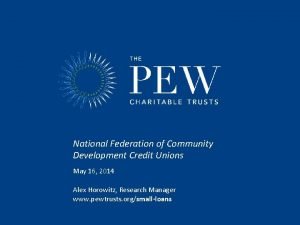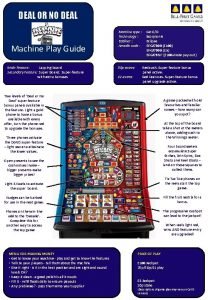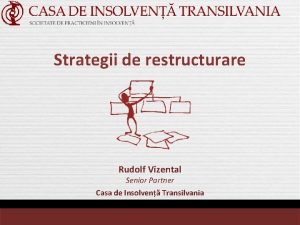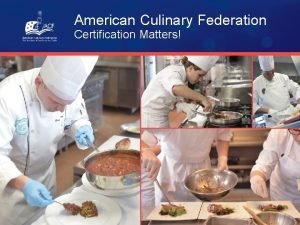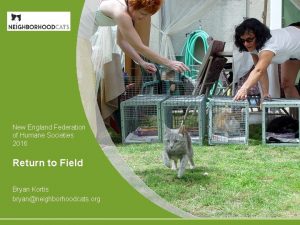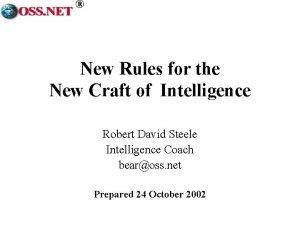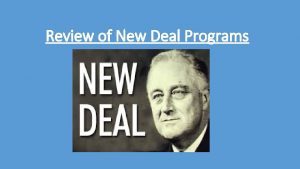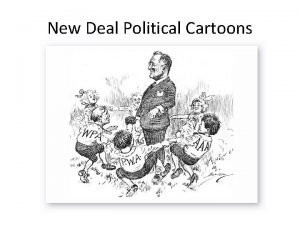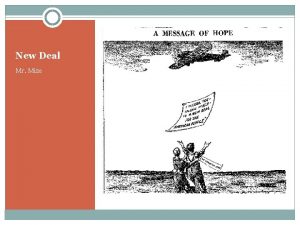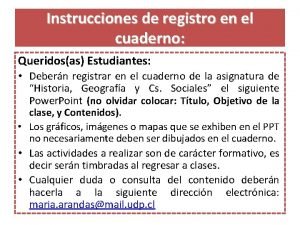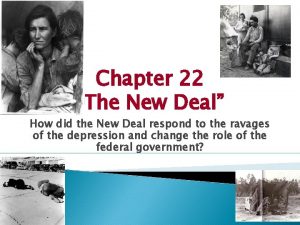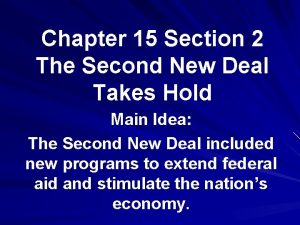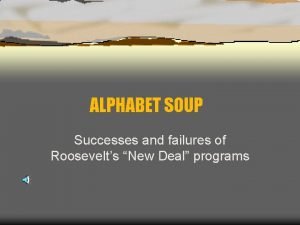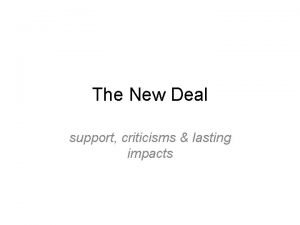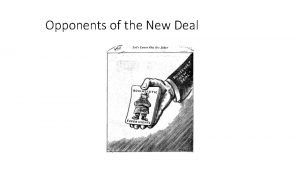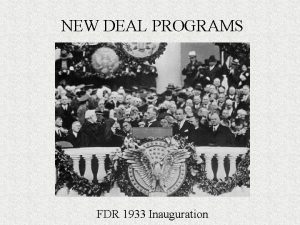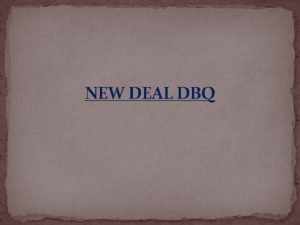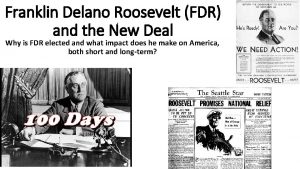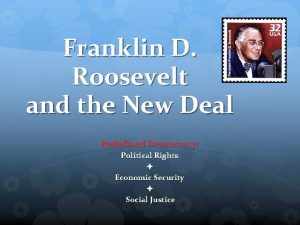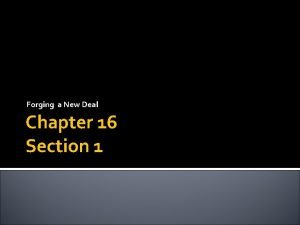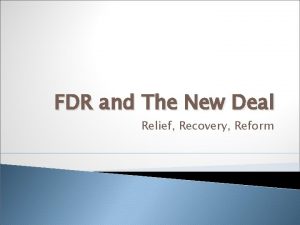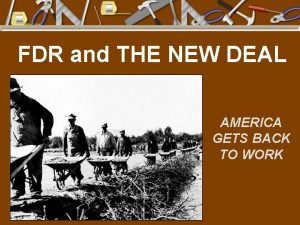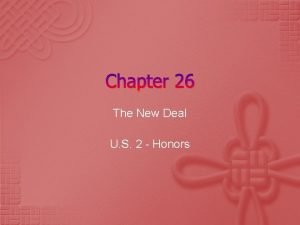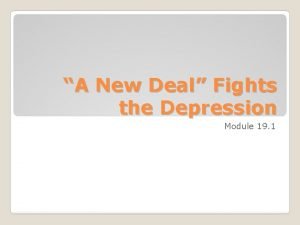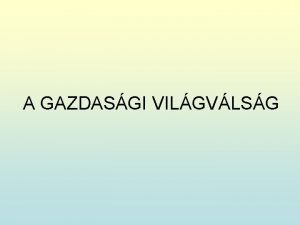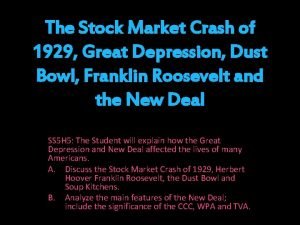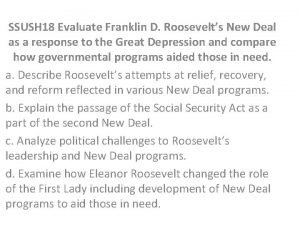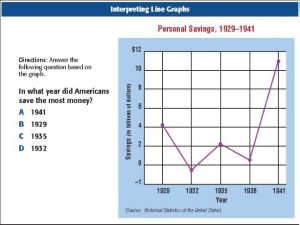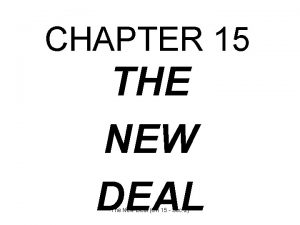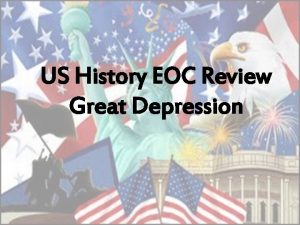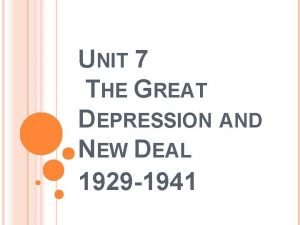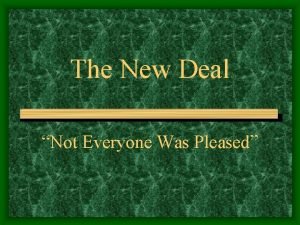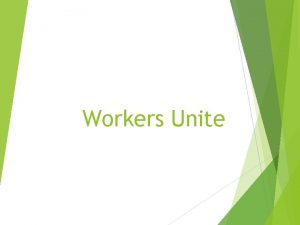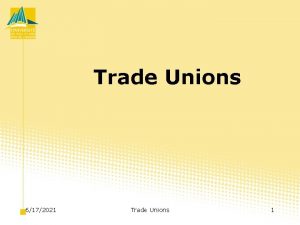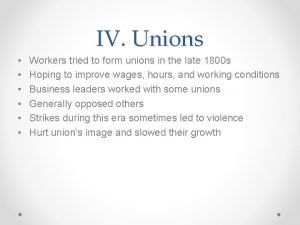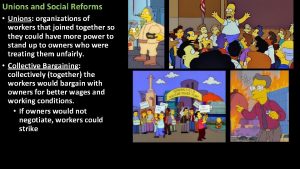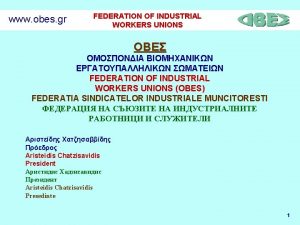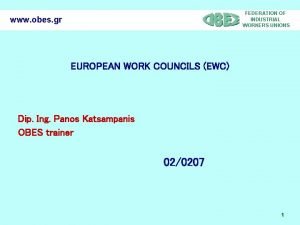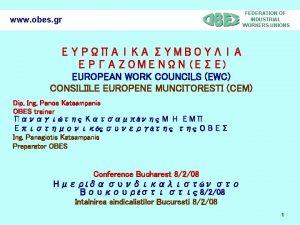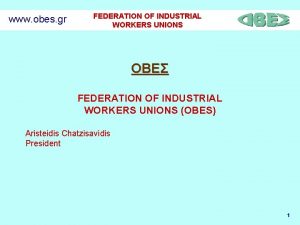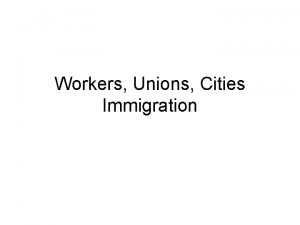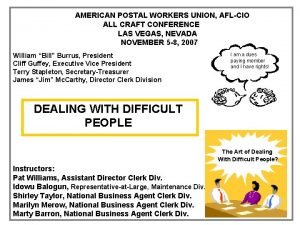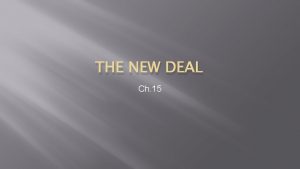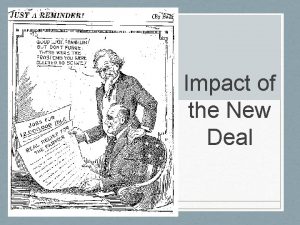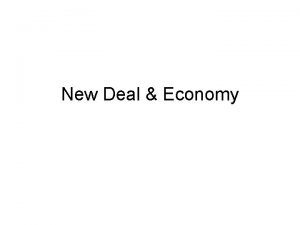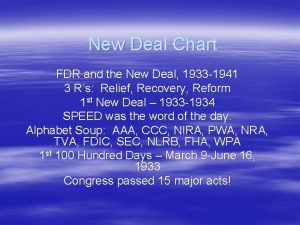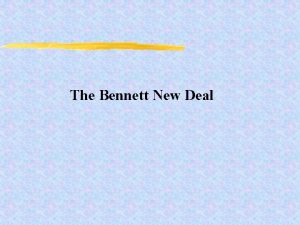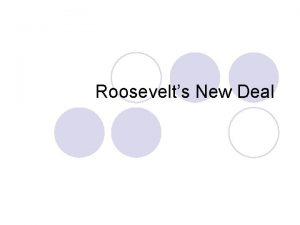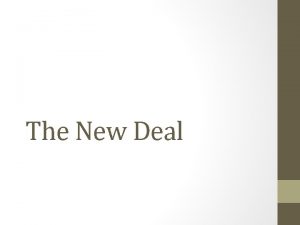New Deal Workers Craft Unions American Federation of











































- Slides: 43

New Deal & Workers

Craft Unions • • • American Federation of Labor Skilled workers Organized by craft “Aristocracy of labor” William Green, President, AFL

Industrial Unions • All workers • Organized by industry • Attempts in US – Knights of Labor (1880) – American Railway Union – Socialist Trade and Labor Alliance – Industrial Workers of the World

US Industry in 1920 s • Consolidations & mergers • Mass production – 1919 -1929 capital/worker = plus 36% – Productivity increases • Iron & steel - 55% • Autos - 178% • Rubber tires - 292% • Industrial wages unchanged • Number of workers - minus 2. 9%

Opposition to Unions • “American Plan” (open shop) – National Association of Manufacturers • Unions = communists • Failed steel strike 1919 • Railroad strike 1922 – Federal injunction • Union membership – Increases in craft unions – Decreases in industrial unions

Government Opposition • Industrial Workers of the World – Government raids - 1917 – State laws re “criminal syndicalism” • Red Scare & Palmer Raids 1919 -1920 • Espionage & Sedition Acts -1917 -1918 • Immigration laws - 1917, 1918, 1920

Agitation under Hoover • Unemployed Councils - 1930 – Organized by Communist Party • • Hunger marches on Washington Bonus Army East coast textile strike - 1931 Coal strikes - 1930 -31

FDR & Workers • Paternalist – Work for workers – Workers incapable of helping themselves • Urban workers: low priority • Expert reformers/social workers • Frances Perkins

Frances Perkins • • • Born Boston 1880 Mt Holyoke, Columbia Hull House Advocate for workers NY Industrial Commissioner 19291932

NIRA Labor Provisions • AFL & Garment Unions supportive – Favor high wage companies – Spur planning, stabilization & rationalization • NAM – Assured that Section 7 a would allow open shop

NIRA: Labor Impact • Section 7 a authorized collective bargaining – – UMW (John L. Lewis) took advantage Few other successes Companies created “company unions” Key decision: Company unions in auto industry • Section 7 c allowed setting minimum wages & hours – 40 hours/week -- usual • Labor boards

FDR Administration Views • Favored union participation • Did not support union shop – Allow company unions or multiple unions • Keep existing agreements • Weak Labor Board • Sided with management in key disputes

Minneapolis Trucking Strike • Summer 1934 • Participants: – Citizens Alliance – International Brotherhood of Teamsters – Farmer-Labor Party – Governor Floyd Olson

Minneapolis Strike • Violent clashes • Olson’s intervention – Essential goods only • Broad support from other unions – Threat of general strike

San Francisco General Strike • Summer 1934 • International Longshoreman’s Association • Joint Marine Strike Committee • Harry Bridges

San Francisco Strike • ILA breakaway • July 5, 1934 - clash between police and strikers • General strike -- July 16 -19 • Central Labor Council • Government arbitration • ILA ultimately won its demands

1934 Textile Strike • Unions demands – Recognize union – End “stretch out” • Wages, hours, workloads • State intervention -- Rhode Island & South • FDR committee • UTW – Accepted recommendations – Achieved none of its goals

Union Growth 1933 -35 • One million new union members – United Mineworkers – United Textile Workers – International Ladies Garment Workers – Amalgamated Clothing Workers

Causes of Union Activity • • • Economic conditions FDR: no repression General inclination to reform Socialist & Communist organizers Business opposition to Section 7 a

Robert F. Wagner Sr. • Born Germany 1877 • CCNY, NY Law School • NY Legislature • US Senator 19261949

National Labor Relations Act • • “Wagner Act” Introduced 1934; blocked by FDR Re-introduced 1935; opposed by FDR Passed Senate, 63 -12 FDR declared “must” legislation Passed House on voice vote Signed July 5, 1935

National Labor Relations Act • • National Labor Relations Board Outlawed specified unfair labor practices Encouraged collective bargaining Did not cover – – Railroad workers Farm workers Domestic workers Government employees

Communist Party & Unions • CPUSA – >30, 000 members at one time – Circa 130, 000 total during 1930 s • Independent unions pre-1935 • Within AFL & CIO post-1935

Labor & 1936 Election • Unions contributed $700, 000 to FDR’s campaign • 2/3 from United Mine Workers (UMW) • Formed Labor’s Non-Partisan League – Campaigned for FDR & Dems


John L. Lewis • • • Born Iowa 1880 Miner; organizer Pres. UMW, 1920 -60 Autocrat Republican Supported Hoover in 1932

Committee for Industrial Organization • Interest among auto & other workers • 1935 AFL Convention – Lewis proposes industrial unions – Loses, but draws attention • Dissident unions formed the CIO • Suspended from AFL in 1936 • Congress of Industrial Organizations

CIO Leaders • • Charles Howard (Typographical Union) Philip Murray (UMW) Sidney Hillman, (Clothing Workers) David Dubinsky (Ladies Garment Workers) • Max Zaritsky (Hatters)

Akron Rubber Strike • January 1936 • Local reaction to longer hours • Sit down strikes at Goodyear, Goodrich & Firestone • Goodyear refused settlement • Goodyear strike lasted until March • Concessions, but unrest until 1941

Auto Strikes • • • November 1935 Local strikes began in Atlanta Spread nationwide December 1936: sitdown strike in Flint January 11, 1937: clash with police Gov. Murphy – Sent troops to protect workers – Forced settlement

Auto Strike: Aftermath • UAW membership: – 88, 000 in January 1937 – 400, 000 in October 1937 • March 1937 – 170 sit down strikes – 167, 210 workers • US Steel agreement with Steel Workers Organizing Committee

Resistance to Unions • Ford, Goodyear, Republic Steel • Final settlements in 1941 • Eve of WWII

1937 Memorial Day Massacre • Republic’s South Chicago mill • Clash between strikers & police • 10 strikers killed; 58 hurt

Battle of the Overpass • May 1937 • River Rouge plant • Ford security guards attack Walter Reuther & UAW leaders

FDR on Republic Steel Strike “A plague on both your houses”

Lewis’ Response “It ill behooves one who has supped at labor’s table to curse with equal fervor and fine impartiality both labor and its adversaries when they become locked in deadly embrace. ”

Senate Civil Liberties Committee • La. Follette - chairman • Documented anti-union activities – Industrial espionage – Stockpiling weapons – Strike breakers – Private police – Propaganda

Reaction to Union Growth • House Committee on Un-American Activities – Martin Dies - Chairman – “Rid unions of leftists” • • Foreign Agent Registration Act -1938 1939 Relief Act Hatch Act - 1939 Espionage Act - 1940

End of Sit Down Strikes • 1939 Supreme Court decision • NLRB v Fansteel Metallurgical – Ok to prosecute for trespass – Ok to dismiss workers – Regardless of unfair labor practices

Wages & Hours Legislation • • FDR support Southern & union opposition Claude Pepper & 1938 Fl. Primary Supreme Court shift

Fair Labor Standards Act • Outlawed child labor • $0. 25/hour & 44 hours/week • After 2 years: $0. 40/hour & 40 hours/week • Covered about 25% of workers – Domestic & farm workers excluded – Other exclusions

FLSA: Immediate Impact • Raised pay for 12 million workers

Labor Unions & New Deal • FDR administration – Acquiesced to union growth – Brought unions within statutory framework • Unions produced – Higher wages & better working conditions – Bitter business & rural opposition – Congressional opposition
 National federation of community development credit unions
National federation of community development credit unions Deal or no deal machine
Deal or no deal machine Asset deal vs share deal
Asset deal vs share deal Acf certification levels
Acf certification levels American federation of labor
American federation of labor Native american skywalkers
Native american skywalkers New england federation of humane societies
New england federation of humane societies Robert david steele the new craft of intelligence
Robert david steele the new craft of intelligence Only after food has been dried or canned
Only after food has been dried or canned Great depression and new deal vocabulary
Great depression and new deal vocabulary New deal alphabet soup
New deal alphabet soup The new deal affects many groups
The new deal affects many groups John steinbeck apush
John steinbeck apush Aaa new deal
Aaa new deal Jonah 1938 political cartoon meaning
Jonah 1938 political cartoon meaning Rrr new deal
Rrr new deal Impacto de la gran depresion en chile
Impacto de la gran depresion en chile Ebra new deal
Ebra new deal The ingenious quarterback analysis
The ingenious quarterback analysis Chapter 15 section 2 the second new deal
Chapter 15 section 2 the second new deal New deal alphabet soup
New deal alphabet soup Lasting impacts of the new deal
Lasting impacts of the new deal New deal
New deal Dust bowl migration map
Dust bowl migration map New deal critic dr francis townsend
New deal critic dr francis townsend The new deal webquest
The new deal webquest New deal programs
New deal programs William lloyd garrison jr new deal
William lloyd garrison jr new deal New deal
New deal The new deal redefined the role of the
The new deal redefined the role of the Forging a new deal section 1 answers
Forging a new deal section 1 answers Sec new deal relief recovery reform
Sec new deal relief recovery reform Nlra poster
Nlra poster The new deal
The new deal A new deal fights the depression
A new deal fights the depression New deal intézkedései
New deal intézkedései To introduce new just to deal
To introduce new just to deal Black thursday
Black thursday New deal program
New deal program Sec new deal
Sec new deal Tennessee valley basin
Tennessee valley basin Main idea
Main idea Franklin d. roosevelt
Franklin d. roosevelt New deal everyone
New deal everyone
